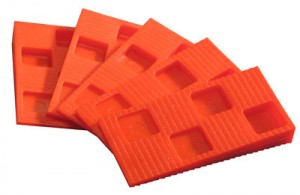 In part three in our mini-series about some of the things you’ll need to succeed in installing and caring for wood flooring, here’s a few words about some simple, yet vital, tools necessary to a flooring installation.
In part three in our mini-series about some of the things you’ll need to succeed in installing and caring for wood flooring, here’s a few words about some simple, yet vital, tools necessary to a flooring installation.
There are a couple things to keep in mind when installing floors when it comes to individual boards, and for the floor as a whole. First, the floor boards are not indestructible, as durable as they are. And second, they will do what comes naturally after they’ve been installed, which means that they will move. This means that the expansion gap you leave should be even.
To cover both of these aspects of wood flooring installation, there are two items to consider to see to both of these aspects. The first is the tapping block, and the second are spacers. Both are vital to your success. But, “how?” you ask.
How, indeed.Let’s look at the tapping block, or “knock block”, first. Here’s our Matt demonstrating the use of the tapping block to accomplish two goals. The first is protecting the tongue of the board from being damaged by the mallet, and second to even out the force along the board, so that it slides into the groove more easily. Take a look.
By the way, this installation depicted in this video is very out of the ordinary, since it’s being done outside (a bad idea for any wood floor). The video was a part of our ‘Watch Us Wreck A Floor’ series. That’s why you hear my voice droning on about the weather! Some of you may have seen it already, and to those who haven’t, the link above will explain just what we were thinking with such a crazy, and in every practical sense ill-advised decision to install a wood floor outside.
Anyway, getting back to being a flooring superhero, using the tapping block is only a part of the installation.
When you’re establishing an expansion gap, you’ll need spacers to help you do it properly. Spacers are wedges of wood or plastic which slide in between your floor board and the wall. This creates an even gap of about an inch around the perimeter of your room, and around stationary objects like pillars, too. When you’re floor expands and contracts – note, not if but when – the gap that you’ve created using spacers will allow that movement without causing crowning and cupping.
Cheers!
Rob.
![[object Object]](https://assets.builddirect.com/images/logo-blue.png?auto=format&fit=max&w=384)


















